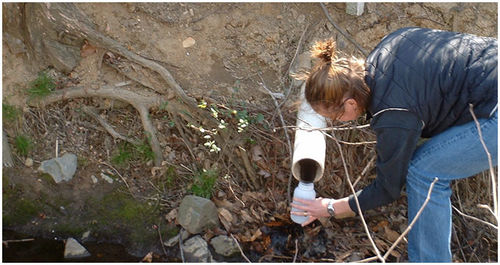
Difference between revisions of "MCM 3 Illicit Discharge Detection and Elimination"
| Line 3: | Line 3: | ||
The illicit discharge detection and elimination (IDDE) program must include: | The illicit discharge detection and elimination (IDDE) program must include: | ||
| − | :# | + | :#A map of the MS4 that includes all pipes 12 inches or greater and their flow direction; outfalls, including the unique identifier and geographic coordinates; municipally owned or operated structural stormwater best management practices (BMPs); and all receiving waters. |
:#A regulatory mechanism to prohibit illicit discharges. The EPA has model ordinance language [https://www.epa.gov/sites/production/files/2015-12/documents/modelillicit.pdf here]. | :#A regulatory mechanism to prohibit illicit discharges. The EPA has model ordinance language [https://www.epa.gov/sites/production/files/2015-12/documents/modelillicit.pdf here]. | ||
| − | :#The incorporation of illicit discharge | + | :#The incorporation of illicit discharge detection into all inspections and maintenance activities, such as those conducted on ponds, outfalls, and other structural stormwater BMPs. These inspections should be conducted during dry weather, when possible. |
:#Detecting and tracking the source of illicit discharges using visual inspections. | :#Detecting and tracking the source of illicit discharges using visual inspections. | ||
:#Training all field staff on illicit discharge recognition. | :#Training all field staff on illicit discharge recognition. | ||
:#Identifying priority areas likely to have illicit discharges by evaluating land uses associated with business and industrial activities, areas where illicit discharges have been observed in the past, areas with storage of large quantities of materials that could result in an illicit discharge. These locations should have additional illicit discharge inspections. | :#Identifying priority areas likely to have illicit discharges by evaluating land uses associated with business and industrial activities, areas where illicit discharges have been observed in the past, areas with storage of large quantities of materials that could result in an illicit discharge. These locations should have additional illicit discharge inspections. | ||
| − | :#Procedures for investigating, locating, and eliminating the source of illicit discharges | + | :#Procedures for investigating, locating, and eliminating the source of illicit discharges. |
| − | :#Spill response procedures. These procedures must include the requirement to notify the Minnesota Duty | + | :#Spill response procedures. These procedures must include the requirement to notify the Minnesota Duty Officer. |
:#Enforcement Response Procedures. | :#Enforcement Response Procedures. | ||
:#Documentation as required [https://stormwater.pca.state.mn.us/index.php?title=Documentation_requirements_and_documents_to_retain_under_the_MS4_permit here]. | :#Documentation as required [https://stormwater.pca.state.mn.us/index.php?title=Documentation_requirements_and_documents_to_retain_under_the_MS4_permit here]. | ||
Revision as of 20:36, 6 November 2017
Our storm sewer systems carry water directly to our lakes, rivers, and wetlands without additional treatment, so to prevent pollution from entering our surface water, only clean stormwater should enter a storm sewer system. If any other discharge enters the system, it is usually an illicit discharge. Minimum Control Measure (MCM) 3 of the MS4 General Permit requires permittees to develop and implement a program to detect and eliminate illicit discharges within their storm sewer system.
The illicit discharge detection and elimination (IDDE) program must include:
- A map of the MS4 that includes all pipes 12 inches or greater and their flow direction; outfalls, including the unique identifier and geographic coordinates; municipally owned or operated structural stormwater best management practices (BMPs); and all receiving waters.
- A regulatory mechanism to prohibit illicit discharges. The EPA has model ordinance language here.
- The incorporation of illicit discharge detection into all inspections and maintenance activities, such as those conducted on ponds, outfalls, and other structural stormwater BMPs. These inspections should be conducted during dry weather, when possible.
- Detecting and tracking the source of illicit discharges using visual inspections.
- Training all field staff on illicit discharge recognition.
- Identifying priority areas likely to have illicit discharges by evaluating land uses associated with business and industrial activities, areas where illicit discharges have been observed in the past, areas with storage of large quantities of materials that could result in an illicit discharge. These locations should have additional illicit discharge inspections.
- Procedures for investigating, locating, and eliminating the source of illicit discharges.
- Spill response procedures. These procedures must include the requirement to notify the Minnesota Duty Officer.
- Enforcement Response Procedures.
- Documentation as required here.
Additional resources:
- EPA MCM 3 guidance - EPA guidance and suggested BMPs for an effective illicit discharge detection and elimination program
- EPA Illicit Discharge Fact sheet - EPA fact sheet on MCM 3
- Illicit Discharge Model Ordinance Language - EPA's model ordinance language for municipalities to prohibit illicit discharges and connections
- Illicit Discharge Detection and Elimination A Guidance Manual for Program Development and Technical Assessments - EPA's manual on techniques to detect and correct discharges in municipal storm drains
